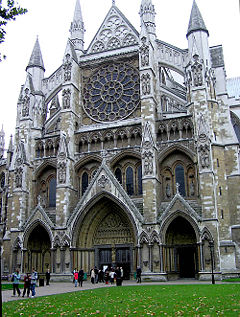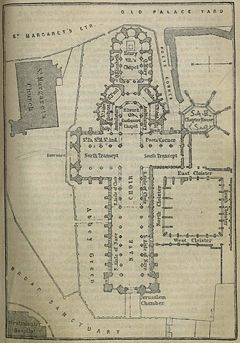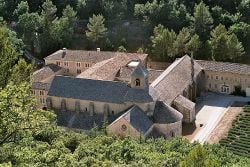Abbey
An abbey (from Latin abbatia, derived from Syriac abba, "father"), is a Christian monastery or convent, under the government of an abbot or an abbess, who serves as the spiritual father or mother of the community.
During the early Middle Ages, European abbeys were the important centers of learning and literacy, which played key roles in the preservation of morality, culture and law, especially during the Dark Ages. This practice remained when many abbeys became universities after the first millennium, and can still be seen at Oxford University and Cambridge University.
Some cities were ruled by heads of an abbey.
History
The earliest known Christian monastic communities consisted of groups of cells or huts collected about a common center, which was usually the house of some hermit or anchorite famous for holiness or singular asceticism, but without any attempt at orderly arrangement. Such communities were not an invention of Christianity. The example had been already set in part by the Essenes in Judea and perhaps by the Therapeutae in Egypt.[1][2][3]
In the earliest age of Christian monasticism the ascetics were accustomed to live singly, independent of one another and not far from some village church, supporting themselves by the labor of their own hands and distributing the surplus after the supply of their own scanty wants to the poor. Increasing religious fervor, aided by persecution, drove them farther and farther away from civilization into mountain solitudes or lonely deserts. The deserts of Egypt swarmed with the "cells" or huts of these anchorites.
Anthony the Great, who had retired to the Egyptian desert during the persecution of Maximian (312 C.E.) was the most celebrated among these monks for his austerities, sanctity, and power as an exorcist. His fame resulted in many followers collecting around him who imitating his asceticism in an attempt to imitate his sanctity. The deeper he withdrew into the wilderness, the more numerous his disciples became. They refused to be separated from him and built their cells around that of their spiritual father. Thus arose the first monastic community, consisting of monks living each in his own little dwelling, united together under one superior. Anthony, as Johann August Wilhelm Neander remarks,[4] "without any conscious design of his own, had become the founder of a new mode of living in common, Coenobitism."
Eventually, some structure was introduced in the groups of huts. They were arranged in lines like the tents in an encampment or the houses in a street. From this arrangement these lines of single cells came to be known as Laurae or Laurai ("streets" or "lanes").
The real founder of cenobitic (koinos, common, and bios, life) monasteries in the modern sense was Saint Pachomius, an Egyptian living in the beginning of the fourth century C.E. The first community established by him was at Tabennae, an island of the Nile in Upper Egypt. Eight others were founded in the region during his lifetime, numbering three thousand monks. Within fifty years of his death his societies could claim 50,000 members. These coenobia resembled villages peopled by a hard-working religious community all of one sex.
The buildings were detached, small and of the humblest character. Each cell or hut, according to Sozomen (H.R. iii. 14), contained three monks. They took their chief meal in a common refectory or dining hall at 3 p.m., up to which hour they usually fasted. They ate in silence, with hoods so drawn over their faces that they could see nothing but what was on the table before them. The monks spent any time not devoted to religious services or study in manual labor.
Palladius, who visited the Egyptian monasteries about the close of the fourth century, found among the three hundred members of the coenobium of Panopolis, under the Pachomian rule, 15 tailors, seven smiths, four carpenters, 12 camel drivers and 15 tanners. Each separate community had its own steward, who was subject to a chief steward stationed at the head establishment. All the produce of the monks' labour was committed to him, and by him shipped to Alexandria. The money raised by the sale was expended in the purchase of stores for the support of the communities, and what was over was devoted to charity. Twice in the year the superiors of the several coenobia met at the chief monastery, under the presidency of an archimandrite ("the chief of the fold," from miandra, a sheepfold), and at the last meeting gave in reports of their administration for the year. The coenobia of Syria belonged to the Pachomian institution. Many details concerning those in the vicinity of Antioch derive from Saint John Chrysostom's writings. The monks lived in separate huts, kalbbia, forming a religious hamlet on the mountain side. They were subject to an abbot, and observed a common rule (they had no refectory, but ate their common meal, of bread and water only, when the day's labour was over, reclining on strewn grass, sometimes out of doors). Four times in the day they joined in prayers and psalms.
The necessity for defence from hostile attacks (monastic houses tended to accumulate rich gifts), economy of space and convenience of access from one part of the community to another, by degrees dictated a more compact and orderly arrangement of the buildings of a monastic coenobium. Large piles of building were erected, with strong outside walls, capable of resisting the assaults of an enemy, within which all the necessary edifices were ranged round one or more open courts, usually surrounded with cloisters. The usual Eastern arrangement is exemplified in the plan of the convent of the Holy Laura, Mount Athos.
Benedictine abbeys
Monasticism in the West owes its extension and development to Saint Benedict of Nursia (born 480 C.E.). His rule was diffused with miraculous rapidity from the original Benedictine monastery at Monte Cassino through the whole of Western Europe, and every country witnessed the erection of monasteries far exceeding anything that had yet been seen in spaciousness and splendour. Few great towns in Italy were without their Benedictine convent, and they quickly rose in all the great centres of population in England, France and Spain.
The number of these monasteries founded between 520 C.E. and 700 C.E. is amazing. Before the Council of Constance (1415 C.E.), no fewer than 15,070 abbeys had been established of this order alone. The buildings of a Benedictine abbey were uniformly arranged after one plan, modified where necessary (as at Durham and Worcester, where the monasteries stand close to the steep bank of a river) to accommodate the arrangement to local circumstances.
No examples remain of the earlier monasteries of the Benedictine order; they have all yielded to the ravages of time and the violence of man. However, han elaborate plan exists of the great Swiss monastery of St. Gall, erected about 820 C.E., which shows the whole arrangements of a monastery of the first class towards the early part of the ninth century. Benedictine rule enjoined that, if possible, the monastery should contain within itself every necessary of life, as well as the buildings more intimately connected with the religious and social life of its monks. It should comprise a mill, a bakehouse, stables, and cow-houses, together with accommodation for carrying on all necessary mechanical arts within the walls, so as to obviate the necessity of the monks going outside its limits.
The general distribution of the buildings may be thus described: The church, with its cloister to the south, occupies the center of a quadrangular area, about 430 square feet. The buildings, as in all great monasteries, are distributed into groups. The church forms the nucleus, as the centre of the religious life of the community. In closest connection with the church is the group of buildings appropriated to the monastic line and its daily requirements—the refectory for eating, the dormitory for sleeping, the common room for social intercourse, the chapter-house for religious and disciplinary conference. These essential elements of monastic life are ranged about a cloister court, surrounded by a covered arcade, affording communication sheltered from the elements between the various buildings. The infirmary for sick monks, with the physician's house and physic garden, lies to the east. In the same group with the infirmary is the school for the novices. The outer school, with its headmaster's house against the opposite wall of the church, stands outside the convent enclosure, in close proximity to the abbot's house, that he might have a constant eye over them.
The buildings devoted to hospitality are divided into three groups—one for the reception of distinguished guests, another for monks visiting the monastery, a third for poor travellers and pilgrims. The first and third are placed to the right and left of the common entrance of the monastery—the hospitium for distinguished guests being placed on the north side of the church, not far from the abbot's house; that for the poor on the south side next to the farm buildings. The monks are lodged in a guest-house built against the north wall of the church.
The group of buildings connected with the material wants of the establishment is placed to the south and west of the church, and is distinctly separated from the monastic buildings. The kitchen, buttery and offices are reached by a passage from the west end of the refectory, and are connected with the bakehouse and brewhouse, which are placed still farther away. The whole of the southern and western sides is devoted to workshops, stables and farm-buildings. The buildings, with some exceptions, seem to have been of one story only, and all but the church were probably erected of wood. The whole compound included 33 separate blocks.
Every large monastery had smaller satellite foundations known as cells or priories. Sometimes these foundations were no more than a single building serving as residence and farm offices, while other examples were miniature monasteries for five or ten monks. The outlying farming establishments belonging to the monastic foundations were known as villae or granges. They were usually staffed by lay-brothers, sometimes under the supervision of a single monk.
Westminster Abbey is an example of a great Benedictine abbey. The cloister and monastic buildings lie to the south side of the church. Parallel to the nave, on the south side of the cloister, was the refectory, with its lavatory at the door.
On the eastern side we find the remains of the dormitory, raised on a vaulted substructure and communicating with the south transept. The chapter-house opens out of the same alley of the cloister. The small cloister lay to the south-east of the larger cloister, and still farther to the east we have the remains of the infirmary with the table hall, the refectory of those who were able to leave their chambers. The abbot's house formed a small courtyard at the west entrance, close to the inner gateway.
Considerable portions of Westminster Abbey remain, including the abbot's parlour, celebrated as "the Jerusalem Chamber," his hall, now used for the Westminster King's Scholars, and the kitchen and butteries beyond.
The history of Christian abbeys is one of alternate periods of decay and revival. With growth in popular esteem came increase in material wealth, leading to luxury and worldliness. The first religious ardour cooled, the strictness of the rule was relaxed, until by the tenth century the decay of discipline was so complete in France that the monks are said to have been frequently unacquainted with the rule of Saint Benedict and even ignorant that they were bound by any rule at all.
The reformation of abuses generally took the form of the establishment of new monastic orders, with new and more stringent rules, requiring a modification of the architectural arrangements. One of the earliest of these reformed orders was the Cluniac. This order took its name from the little village of Cluny, 12 miles northwest of Macon, near which, about 909 C.E., a reformed Benedictine abbey was founded by William, duke of Aquitaine and count of Auvergne, under Berno, abbot of Beaume. He was succeeded by Odo, who is often regarded as the founder of the order. The fame of Cluny spread far and wide. Its rigid rule was adopted by a vast number of the old Benedictine abbeys, who placed themselves in affiliation to the mother society, while new foundations sprang up in large numbers, all owing allegiance to the "archabbot," established at Cluny.
By the end of the twelfth century the number of monasteries affiliated to Cluny in the various countries of western Europe amounted to two thousand. The monastic establishment of Cluny was one of the most extensive and magnificent in France. We may form some idea of its enormous dimensions from the fact recorded, that when, in 1245 C.E., Pope Innocent IV, accompanied by twelve cardinals, a patriarch, three archbishops, the two generals of the Carthusians and Cistercians, the king (St. Louis), and three of his sons, the queen mother, Baldwin, count of Flanders and emperor of Constantinople, the duke of Burgundy and six lords visited the abbey, the whole party, with their attendants, were lodged within the monastery without disarranging the monks, four hundred in number. Nearly the whole of the abbey buildings, including the magnificent church, were swept away at the close of the eighteenth century. When the annexed ground-plan was taken, shortly before its destruction, nearly all the monastery, with the exception of the church, had been rebuilt.
The first English house of the Cluniac order was that of Lewes, founded by the earl of Warren, around 1077 C.E. All Cluniac houses in England were French colonies, governed by priors of that nation. They did not secure their independence nor become "abbeys" till the reign of Henry VI. The Cluniac revival, with all its brilliancy, was but short-lived. The celebrity of this, as of other orders, worked its moral ruin. With their growth in wealth and dignity the Cluniac foundations became as worldly in life and as relaxed in discipline as their predecessors, and a fresh reform was needed.
Cistercian abbeys
The next great monastic revival, the Cistercian, arising in the last years of the eleventh century, had a wider diffusion, and a longer existence. Owing its real origin as a distinct foundation of reformed Benedictines to Stephen Harding (a native of Dorset, educated in the monastery of Sherborne), in 1098 C.E., it derives its name from Citeaux (Cistercium), a desolate and almost inaccessible forest solitude, on the borders of Champagne and Burgundy. The rapid growth and wide celebrity of the order are undoubtedly to be attributed to the enthusiastic piety of Saint Bernard of Clairvaux, abbot of the first of the monastic colonies, subsequently sent forth in such quick succession by the first Cistercian houses, the far-famed abbey of Clairvaux (de Clara Valle), 1116 C.E.
The rigid self-abnegation, which was the ruling principle of this reformed congregation of the Benedictine order, extended itself to the churches and other buildings erected by them. The characteristic of the Cistercian abbeys was the extremest simplicity and a studied plainness. Only one tower—a central one—was permitted, and that was to be very low. Unnecessary pinnacles and turrets were prohibited. The triforium was omitted. The windows were to be plain and undivided, and it was forbidden to decorate them with stained glass. All needless ornament was proscribed. The crosses must be of wood; the candlesticks of iron. The renunciation of the world was to be evidenced in all that met the eye.
The same spirit manifested itself in the choice of the sites of their monasteries. The more dismal, the more savage, the more hopeless a spot appeared, the more did it please their rigid mood. Yet they came not merely as ascetics, but as improvers. The Cistercian monasteries are, as a rule, found placed in deep well-watered valleys. They always stand on the border of a stream; not rarely, as at Fountains, the buildings extend over it. These valleys, now so rich and productive, wore a very different aspect when the brethren first chose them as the place of their retirement. Wide swamps, deep morasses, tangled thickets, wild impassable forests, were their prevailing features. The "bright valley," Clara Vallis of St. Bernard, was known as the "valley of Wormwood," infamous as a den of robbers. "It was a savage dreary solitude, so utterly barren that at first Bernard and his companions were reduced to live on beech leaves" (Milman's Lat. Christ. vol. iii. p. 335).
Abbey-principality
A Prince-abbot is a cleric, who is a prince of the church (like a prince-bishop) in the sense of an ex officio temporal lord of a feudal entity known as prince-abbacy or abbey-principality, which is an area that is ruled by the head of an abbey. The designated abbey may be a monastery or a convent. Thus, because of the possibility of it being a convent, an abbey-principality is one of the only cases in which the rule can be restricted to female incumbents, styled princess-abbess.
In some cases, the prince-abbots were known as princes of the empire of a Reichsabtei in or near Germany, with a seat in the Reichstag (imperial diet). Other examples include the abbot nullius of Pinerolo in Piedmont.
Famous abbeys
Famous Christian abbeys include:
- Monte Cassino
- El Escorial
- Melk Abbey
- Pannonhalma Archabbey
- Buckfast Abbey
- Monastery of Santo Domingo de Silos
- Taizé Community
Other once flourishing abbeys that were dissolved were:
- Fountains Abbey
- Cluny Abbey
- Lindisfarne
- Whitby Abbey
- Rievaulx Abbey
- Glastonbury Abbey
- Westminster Abbey
- St Michael's Mount
- Glendalough
- St Andrews Abbey
- Cluniac monks
- Celestines
Notes
- ↑ Marcel Simon and James H. Farley (trans.), Jewish Sects at the Time of Jesus (Philadelphia: Fortress Press, 1980).
- ↑ Joan E. Taylor, Jewish Women Philosophers of First-Century Alexandria: Philo's "Therapeutae" Reconsidered (Oxford University Press, 2006).
- ↑ Joan E. Taylor and Philip R. Davies, "The So-Called Therapeutae of De Vita Contemplativa: Identity and Character," The Harvard Theological Review 91(1) (Jan. 1998): 3–24.
- ↑ Johann August Wilhelm Neander, Church History, iii. p. 316, Clark's translation.
ReferencesISBN links support NWE through referral fees
- Simon, Marcel and James H. Farley (trans.). Jewish Sects at the Time of Jesus. Philadelphia: Fortress Press, 1980. ISBN 978-0800601836
- Taylor, Joan E. Jewish Women Philosophers of First-Century Alexandria: Philo's "Therapeutae" Reconsidered. New York: Oxford University Press, 2006. ISBN 978-0199291410
- Taylor, Joan E. and Philip R. Davies "The So-Called Therapeutae of De Vita Contemplativa: Identity and Character." The Harvard Theological Review 91(1) (Jan. 1998): 3–24.
- This article incorporates text from the Encyclopædia Britannica Eleventh Edition, a publication now in the public domain.
External links
All links retrieved June 14, 2023.
- Abbey – Catholic Encyclopedia
- Westminster Abbey
Credits
New World Encyclopedia writers and editors rewrote and completed the Wikipedia article in accordance with New World Encyclopedia standards. This article abides by terms of the Creative Commons CC-by-sa 3.0 License (CC-by-sa), which may be used and disseminated with proper attribution. Credit is due under the terms of this license that can reference both the New World Encyclopedia contributors and the selfless volunteer contributors of the Wikimedia Foundation. To cite this article click here for a list of acceptable citing formats.The history of earlier contributions by wikipedians is accessible to researchers here:
The history of this article since it was imported to New World Encyclopedia:
Note: Some restrictions may apply to use of individual images which are separately licensed.



